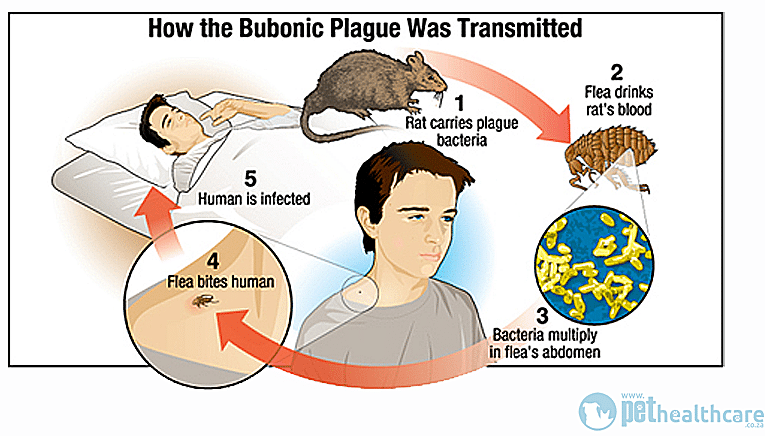In Arizona found fleas infected with the Black Death, the disease that decimated 60% of the European population in the 14th century. Three human cases (recovered)
– Gio, 17/08/2017 – il Giornale.it
Una piaga che ha ucciso, secondo le stime degli storici, circa il 60% della popolazione europea con le sue epidemie scoppiate nel XIV secolo. Solo l’arrivo degli antibiotici ha permesso di debellarla in Europa e Australia, ma sopravvive in alcune zone del Sud America, dell’Africa e in alcuni casi anche negli USA.
The Navajo and Coconino Departments of Health (Arizona), infatti, nei giorni scorsi hanno confermato di aver trovato la peste su alcune pulci nei cani della città di Taylor. L’invito delle autorità, come riporta il Corriere, è stato ovviamente quello alla prudenza, cercando di evitare contatti con gli animali che potrebbero fare da veicolo con le pulci infette: cani, roditori, conigli e i loro predatori.
How the plague può arrivare all’uomo? Basta che una pulce infetta morda un essere umano o che questi entri in contatto con un animale infetto che la Morte Nera può aggredire le difese immunitarie dell’uomo. Semplice e letale, anche se ormai il tasso di mortalità è
The latest cases of infection sull’uomo risalgono a qualche mese fa, all’inizo dell’estate, quando tre persone sono state ricoverate a Santa Fe, nel Nuovo Messico. Si trattava di un 63enne e di due donne, di 52 e 62 anni. Tutti sono fuori pericolo di vita dopo aver passato qualche giorno in ospedale.
The numbers collected by Center for Disease Control ( CDC ) parlano di circa mille casi negli Usa tra il 1900 e il 2012, mentre l’Organizzazione Mondiale della Sanità stima in 3mila casi il totale di infezioni all’anno in tutto il mondo. L’anno peggiore per gli Stati Uniti è stato il 2006, quando 2 persone persero la vita a causa della Morte Nera.
Ed: Nell’immagina a sinistra il medico della peste, acquaforte di Paulus Furst 1656 (da J. Columbina): durante l’epidemia di plague of 1656 in Rome doctors believed that this clothing protected from contagion and therefore wore a waxed cloak, a sort of protective goggles and gloves, while aromatic substances were found in the beak
The origin of the plague is very ancient (Thucydides mentions it in the 5th century BC), and due to its destructive force, it has become the 'black death' in the collective imagination, the disease that has accompanied humanity over the centuries and which for this reason it is often present in the great literary and artistic works. The story of the Great Plague in Europe in the 1350s, which claimed the lives of almost a third of Europe's population and literally infected every country from the Mediterranean to Scandinavia and Russia within five years, is particularly sinister because it was the consequence of a deliberate act of bioterrorism.
Nel 1347, infatti, l’esercito dei tartari stava assediando Caffa (l’odierna Feodosia), commercial port of the city of Genoa in the Crimea. The ranks of the Eastern army were upset by an epidemic of plague, which had spread in Asia for some years and so the khan Ganibek decided to use the infected bodies of the dead soldiers to conquer the city, catapulting them beyond the walls. Genoese sailors escaping from Caffa brought the plague to the Mediterranean ports and from there the disease spread throughout Europe. And in Europe it remained endemic, returning in cycles of 10-12 years, for at least the following three centuries. In recent scientific research, using new techniques, scientists Hendrik Poinar, Kirsti Bos and Johannes Krause have proved that it was a variant of Yersinia pestis, now extinct, to cause the first epidemic between 1347 and 1352
I medici dell’epoca rimasero disorientati di fronte a questo fenomeno, per loro incomprensibile. In caso di peste l’unico dovere del medico era di invitare l’ammalato a confessarsi. Il rimedio cui i medici più frequentemente ricorrevano erano fumigazioni con erbe aromatiche quali ad es. rosmarino menta e limone, che in effetti efficacemente repellono le pulci; purtroppo però applicare queste pratiche ad un contagiato era completamente inutile.
The pathogen of the plague is Yersinia pestis discovered in 1894 by Alexandre Yersin. It is a Gram-negative coccobacillus belonging to the non-coliform Enterobacteriaceae family.
To reduce the chances of death it is essential to treat with antibiotics within the first 24 hours of the onset of symptoms, with streptomycin, gentamicin, tetracyclines or chloramphenicol. Treatment with antibiotics is recommended, according to the American CDC, for seven days even in people who potentially come into contact with the patient
Corriere della Sera. Plague outbreak in Arizona, infected fleas and three human cases (recovered)
But what I cannot enter belongs to these gentlemen doctors; confess that we find ourselves under such an evil conjunction, and then come and tell us, with cheek: don't touch here, don't touch there, and you'll be safe! As if this avoidance of material contact with earthly bodies could prevent the virtual effect of celestial bodies! And so much toil to burn rags! Poor people! will you burn Jupiter? will you burn Saturn?
His fretus, that is to say [ed: trusting] on these beautiful foundations, he took no precautions against the plague; clung to him; he went to bed, to die, like a Metastasio hero, blaming the stars.
(Don Ferrante - The Betrothed, chapter XXXVII - A. Manzoni)
